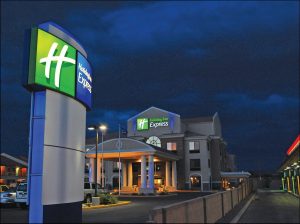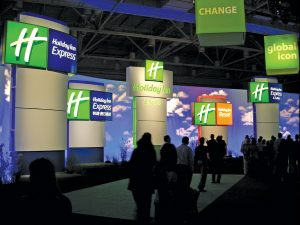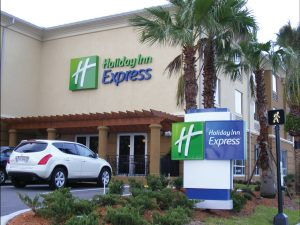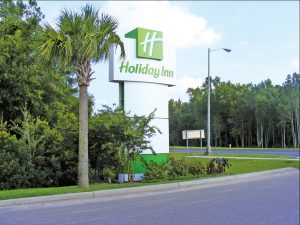Business Management
The Holiday Inn Global Brand Relaunch
So far, approximately 1,875 North American locations have spent an estimated $140 million on signage.
Published
14 years agoon
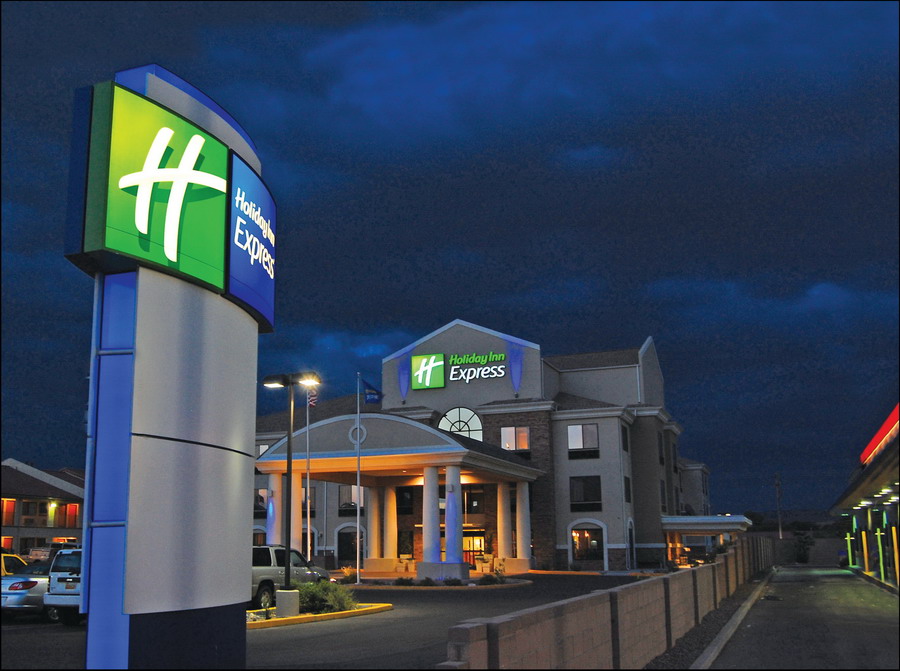
Chris Fitzgerald, the vice president for Nashville, TN-based Sign Management Consultants (SMC), had primary responsibility for overseeing the entire program in North and South America: prototyping, design engineering, the bid process, qualifying fabricators, inspecting every completed project, and, perhaps more impressively, maintaining communications with both vendors and the individual franchise owners. A detailed report could fill this entire magazine, but here, Chris outlines some of the highlights. The Holiday Inn global brand relaunch is on track to be completed this year.
SMC began working on the Holiday Inn global brand relaunch program in May 2006 with a survey project. From then until November 2006, we surveyed every Holiday Inn/Holiday Inn Express facility in the world: approximately 3,200 surveys in 67 countries. The parent company, InterContinental Hotels Group (IHG), has seven brands, which include the Holiday Inn and Holiday Inn Express brands, which are considered two separate entities.
Early in 2007, IHG hired a design firm (Interbrand Design Forum, Dayton, OH) to design the new logo and brands for the Holiday Inn brands. SMC participated in the concept and design-feasibility discussions. Once the overall concept was determined, we began designing and building prototypes.
Originally, the relaunch was limited to 800 to 900 Holiday Inn hotels. Later the 1,200 to 1,300 Holiday Inn Express hotels were added. Even though the two brands’ logos are similar, SMC needed to treat the two brands as separate programs.
SMC leased a secluded warehouse in Atlanta (where IHG’s Americas corporate offices are based), where all three groups could examine the prototypes we built. Dubbed “Site 52,” it provided a testing facility for everything from wall signs to high-rise signs. We were under pressure to provide working models in time for the brand unveiling at IHG’s annual investors’ conference slated for October 2007 in Dallas. Very few people had even seen the new logo prior to this event. We designed, manufactured and shipped these models first to Site 52, and then to Dallas, in six weeks.
The investor’s conference kicked things off into the next phase. We prototyped a significant percentage of the roughly 700 sign models from then until February 2008. This necessitated a notable engineering package, which was developed concurrently with the working models. Five sign companies built these prototypes.
Illumination for the entire project is roughly 80% LEDs (see ST, November 2009, page 46) and 20% fluorescent. The pylons are roughly 60% LEDs and 40% fluorescent. All of the “H” monogram sign cabinets and channel letters are lit with LEDs.
That same month, the parameters of both the overall program and signage were finalized. Signage was only a portion of the overall global-relaunch program. Individual hotel owners weren’t permitted to have the new signs until they met quality standards and fulfilled brand hallmark requirements of the relaunch, including a refreshed guestroom and bathroom, a new service promise, and a redesigned welcome experience. The entire relaunch was a $1 billion investment across 3,300 hotels worldwide. The signage portion accounts for approximately $140 million.
Each hotel relaunch was to be completed in four months, with signage as the last component. Consequently, coordination was tricky with so many participants and strict parameters. Once the other requirements were fulfilled, new signage was due within two weeks. Minimal inconvenience to guests was a priority.
Part of our survey service to IHG included sign-code research for every hotel. This allowed us to proactively address any local sign-code issues prior to making recommendation drawings. Generally, the new signs were smaller than the old ones. We designed the signs to have the same visual impact, yet be more code-friendly.
Every hotel paid for its hallmark items separately. For us, this has meant 1,875 individual bid procedures, while still adhering to the four-month window.
We couldn’t have managed this without our inhouse SMC Primis Framework. We developed this database system to facilitate information exchange and project coordination between IHG, the hotel owners, SMC and the sign fabricators. We’d been using our inhouse-developed system for several years, but, based on this project’s complexity, we gave Primis a $500,000 accelerated evolution. It ensured all schedules were met, and all data was tracked. IHG told us the software rated very highly in relaunch satisfaction surveys.
During Spring 2008, SMC gathered RFIs and analyzed the vendor pool. We set up booths at 20 IHG mini-conferences, which generated abundant feedback from hotel owners, some of whom recommended sign companies. Coupled with our own industry knowledge, this feedback helped generate a pool of 85 sign companies, which we narrowed down to 22 North American shops. Geography, experience and capacity were significant factors in the selection, but qualified companies were allowed to bid on any and all jobs at any relaunch site. Ten companies ended up providing 80% of the work in
all areas of the country. The only exceptions were two Mexican sign companies that we only allowed to bid on jobs in Mexico.
Overall, we received approximately 18,000 bids via our Primis system. Sign companies simply keyed in their numbers. The individual hotels could review bids, and subsequently award contracts, online.
The sign companies were responsible for entire locations: permitting, removals, wall repair, fabrication and installation. Once a job was awarded, the sign company worked hand in hand with an SMC project manager to coordinate schedules and resolve site-specific issues.
Subcontracting was limited to the digitally printed, flexible-face sign faces. We spent significant time getting the gradation exactly right, and we wanted to ensure consistency throughout the program. We selected Miratec, Seriprint and Z3 Graphics as qualified subcontractors, and the sign companies determined who provided the work.
Just before the official rollout commenced, IHG wanted to field-test the signs and other relaunch components. Eighteen hotels were chosen for this pilot program. Due to time constraints, the same five manufacturers who had built the prototypes built the signs for these 18 locations.
The program officially kicked off in June 2008. Because all participating sign companies had to build full-scale models of the signs before they could participate, we needed to use the same “Fab Five” initially. This prototyping period for other sign companies required varying amounts of time, so their initial participation was staggered. Most were ready by mid-August.
Qualification was only the initial phase of quality control. SMC employees made subsequent in-plant product inspections. SMC pledged to perform post-installation, day/night inspections at every hotel within six weeks of their completion. The sign company needed to correct any deficiencies. After that, any maintenance contracts were at the hotel owners’ discretion.
By August 2008, all of the sign companies were bidding on the individual projects, and it’s now in the home stretch. The Holiday Inn global brand relaunch is on track to be completed this year.
This was a significant project for SMC. At times we devoted all of our 35-person workforce to the Holiday Inn brands, but never less than 15 full-time employees. We’ve been fortunate to have a client like IHG who has allowed us to implement such a complete program for maintaining brand standards.
The Chronology
Here are some highlights of the new Holiday Inn signage implementation.
2006 May: SMC begins its survey project in North and South America.
July: Survey project begins for Asia-Pacific and Europe-Africa.
November: All surveys are completed.
2007 March: Discussions begin about the new signs.
June: Initial concepts for the new signs are established.
October: The new brand is unveiled.
December: The pilot program begins at 18 sites.
2008 February: Pilot program installations occur.
March-May: IHG hosts its Roadshow meetings.
June: SMC begins holding the Vendors’ Conference. The first program signage begins to be installed.
November: The second SMC Vendors’ Conference is held.
2009 July: New signage is installed at 1,000 hotels.
2010 March: Signage is completed at 2,000 hotels.
December: All hotels are to be converted.
The Importance of Signs to Holiday Inn
Owner is the quarterly magazine for people who are members of the International Assn. of Holiday Inns (IAHI). The cover story for its First Quarter 2008 issue focused on the new sign program. The opening paragraph is fabulous.
“The job of signage is to drive business. Therefore, a sign is not art, it is essence. It’s the point of con-centration of the brand, in all its ethos and attitude. Its purpose is to guide us and help us choose. For today’s customers, personality and identity are the most significant factors in making choices between one business and another.”
The article describes identity signage as “strategy made visible” and praises Sign Management Consultants (SMC) for “translating the new symbol of Holiday Inn from ink and paper to aluminum and lighted acrylic – without loss of design integrity. [SMC] President Paul Bain and his team performed their particular wizardry to refine the prototypes, increase their effectiveness, maintain quality, environmental standards and consistency – and make them work in every scenario.”
Those design concepts weren’t left to chance. As the article explains, “Of course, an investment of the magnitude of a global brand relaunch demands consumer testing. In studies across the U.S., Europe and China, the new identity delivers against the new positioning and resonates with strategic segments. It scores high on Appeal and Attraction to Stay, and extremely high on Readability. All that and it tested more noticeable versus competitors’ signage.”
The concluding paragraph reads, “A simple symbol animates a powerful idea in a person’s mind. The apple. The arches. The swoosh. And now the H, as the Holiday Inn legacy is made relevant to a new generation – from the age of the Hudson Hornet to the era of Toyota minivans – while the rebranding Inns deliver the promise made.”
Holiday Ja Vu
ST’s November 1982 cover story concerned Holiday Inn’s last major changeover, when 1,750 Great Signs were replaced in 56 countries. Who was involved? To quote from the article, “To independently evaluate engineering specifications, including a pilot program in San Antonio, TX, Holiday Inns retained Paul Bain, Sign Management Consultants, Nashville, TN, whom Purvis [with sign designer S&O Consultants] credits with engineering and modifying lighting elements to effectively utilize metal halide for the new system, thus solving ‘hot spot’ problems.”
Chris Fitzgerald observed, “Twenty-eight years of advanced technology and materials make a
difference, and the contrast is obvious. However, the more things change, the more they remain the same. In this program, you still have Sign Management Consultants, the same client and the same criteria. Back then, Holiday Inn asked us to provide them with ‘state of the art’ design and energy savings. We introduced flexible faces, metal-halide lighting, aluminum instead of steel, and pre-finished metal panels.”
Why did the design change occur in 1982? When the Great Sign debuted in 1952, 95% of its customers were vacationing families without reservations. By 1982, however, IHG estimated that less than 3% of its clientele were walk-ins. The thinking was business people and single travelers preferred “a more sophisticated, contemporary image.”
The average cost of the Great Sign had been approximately $35,000, but its replacement averaged $23,000. Energy costs were reduced from $6,100 annually to $2,250. All told, the new signs were expected to pay for themselves in five years.

SPONSORED VIDEO
Introducing the Sign Industry Podcast
The Sign Industry Podcast is a platform for every sign person out there — from the old-timers who bent neon and hand-lettered boats to those venturing into new technologies — we want to get their stories out for everyone to hear. Come join us and listen to stories, learn tricks or techniques, and get insights of what’s to come. We are the world’s second oldest profession. The folks who started the world’s oldest profession needed a sign.
You may like
Advertisement
Subscribe

Magazine
Get the most important news
and business ideas from Signsofthetimes Magazine.
Advertisement
Most Popular
-

 Tip Sheet1 week ago
Tip Sheet1 week agoAlways Brand Yourself and Wear Fewer Hats — Two of April’s Sign Tips
-

 Ask Signs of the Times2 days ago
Ask Signs of the Times2 days agoWhy Are Signs from Canva so Overloaded and Similar?
-

 Real Deal1 week ago
Real Deal1 week agoA Woman Sign Company Owner Confronts a Sexist Wholesaler
-

 Benchmarks4 days ago
Benchmarks4 days ago6 Sports Venue Signs Deserving a Standing Ovation
-

 Editor's Note2 weeks ago
Editor's Note2 weeks agoWhy We Still Need the Women in Signs Award
-

 Women in Signs1 week ago
Women in Signs1 week ago2024 Women in Signs: Megan Bradley
-

 Product Buying + Technology2 weeks ago
Product Buying + Technology2 weeks agoADA Signs and More Uses for Engraving Machines
-

 Photo Gallery6 days ago
Photo Gallery6 days ago21 Larry Albright Plasma Globes, Crackle Tubes and More
